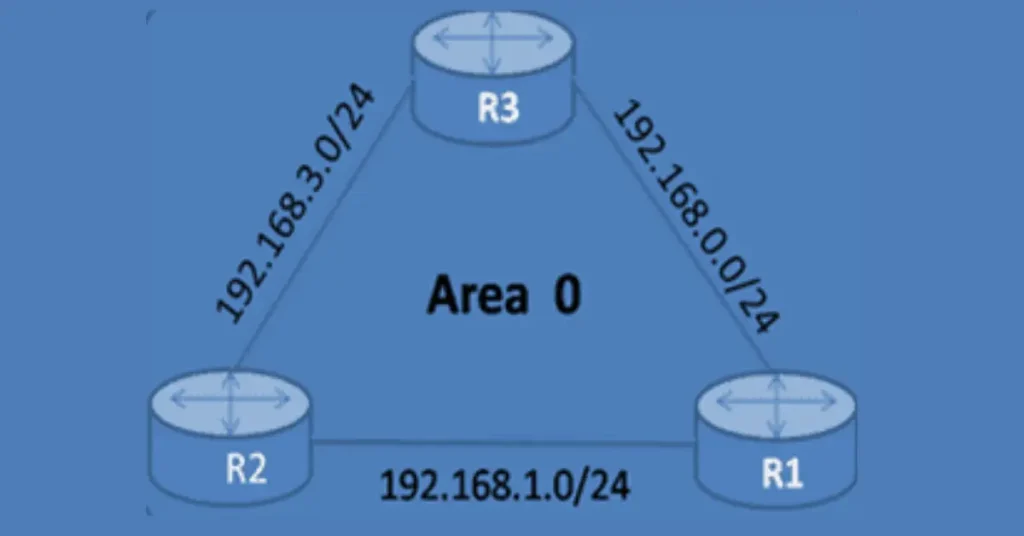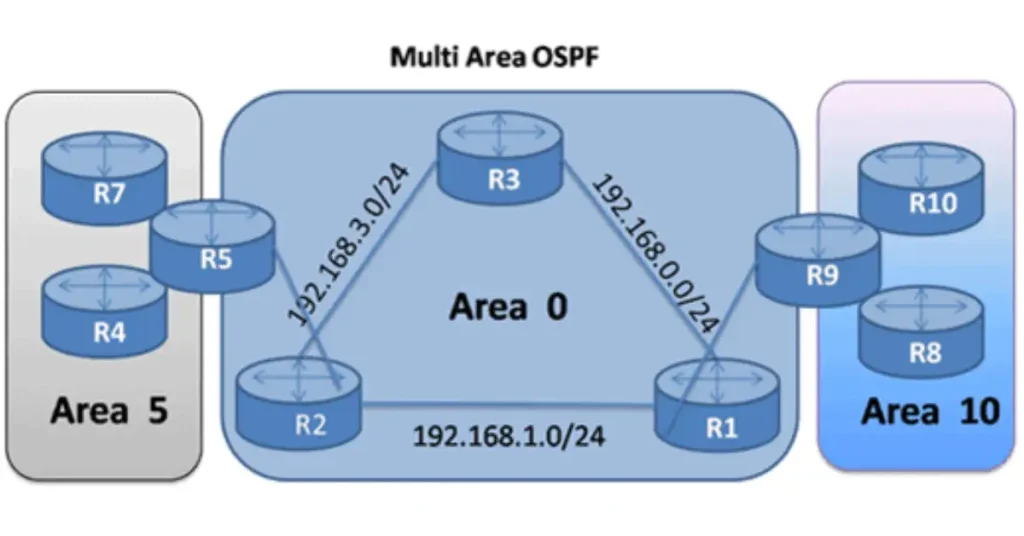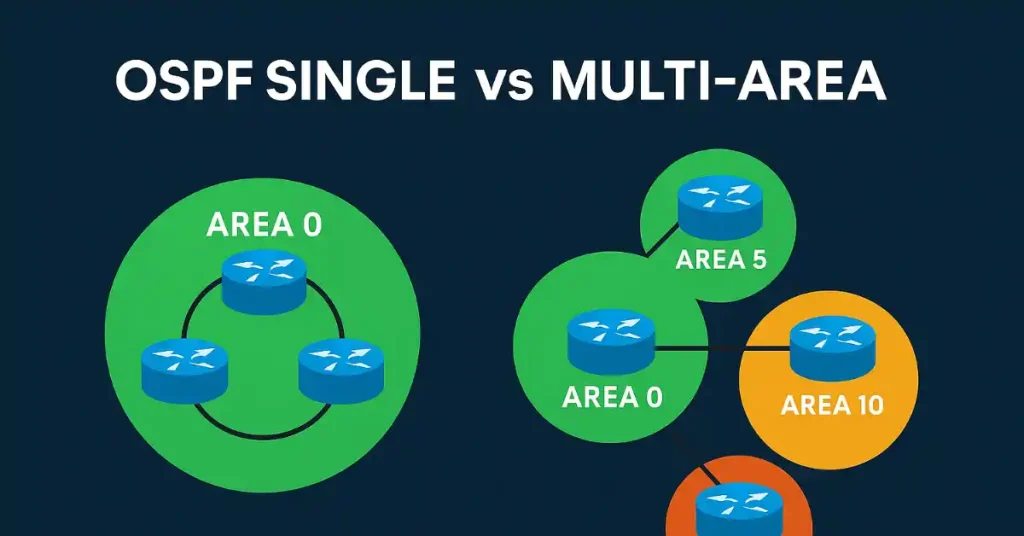Open Shortest Path First (OSPF) is a link-state routing protocol widely used in enterprise IP networks for its efficiency and scalability. Unlike distance-vector protocols like RIP, OSPF uses a hierarchical design, segmenting networks into areas to optimize routing. Each area consists of routers sharing identical Link-State Databases (LSDBs), containing topology information. For CCNA and CCNP students, mastering OSPF is critical for both certification exams and real-world network design. OSPF can be implemented in two primary ways: Single-Area OSPF and Multi-Area OSPF. This article explores both, their advantages, configurations, and best practices, with practical insights for exam preparation and network engineering.
OSPF Basics: How It Works
OSPF operates by exchanging Link-State Advertisements (LSAs) to build a topology map. Routers use the Shortest Path First (SPF) algorithm (Dijkstra’s algorithm) to calculate the best paths based on cost, where cost = Reference Bandwidth (default 100 Mbps) / Interface Bandwidth. For example, a Gigabit Ethernet interface has a cost of 1 (100 Mbps / 1000 Mbps).
Key OSPF components include:
- Hello Packets: Establish and maintain neighbor adjacencies.
- LSDB: Stores LSAs, representing the network topology.
- SPF Algorithm: Computes shortest paths to destinations.
- Router Roles: Designated Router (DR), Backup Designated Router (BDR), Area Border Router (ABR), and Autonomous System Boundary Router (ASBR).
For CCNA, focus on understanding hello packets and basic configurations. CCNP requires deeper knowledge of LSA types, area configurations, and troubleshooting.
Single-Area OSPF (Area 0)
Overview
Single-Area OSPF uses only Area 0, also known as the backbone area, which serves as the core of any OSPF network. It’s ideal for smaller networks with a few routers and straightforward topologies, where managing multiple areas is unnecessary. All routers in Area 0 share the same LSDB and run the SPF algorithm on the full topology.
Challenges in Large Single-Area Networks
As the network grows, single-area OSPF faces scalability issues:
- Large Routing Tables: All routes are stored without summarization.
- Extensive LSDB: Every router maintains a complete topology map.
- Frequent SPF Calculations: Topology changes (e.g., link failures) trigger SPF recalculation across all routers, increasing CPU load.
For example, in a network with 100 routers, a single link flap causes all routers to rerun SPF, impacting performance. The figure below illustrates a single-area OSPF network with all routers in Area 0.
Pros and Cons
- Pros: Simple to configure, no area management, suitable for small setups (e.g., branch offices with 5-10 routers).
- Cons: Poor scalability, high resource usage in large networks.

Multi-Area OSPF
Overview
Multi-Area OSPF divides a large OSPF domain into smaller areas connected to Area 0, the backbone. This hierarchical design enhances scalability by isolating topology changes and reducing resource demands. Area Border Routers (ABRs) connect areas to the backbone, summarizing routes to minimize LSDB size. Autonomous System Boundary Routers (ASBRs) redistribute external routes (e.g., from BGP) into OSPF.
The figure illustrates a multi-area OSPF network, with Area 0 interconnecting Area 5 and Area 10. For example, a topology change in Area 10 triggers SPF only in that area; ABRs send summarized updates to other areas in a distance-vector format, sparing them from SPF recalculation.
Advantages of Multi-Area OSPF
Multi-area OSPF offers significant benefits for large networks:
- Smaller Routing Tables: ABRs summarize routes (e.g., R1 summarizes Area 1’s 192.168.1.0/24 subnets into a single route for Area 0).
- Reduced LSA Overhead: Fewer routers exchange LSAs, lowering processing and memory needs.
- Fewer SPF Calculations: Topology changes are confined to an area; LSA flooding stops at area boundaries.
- Smaller LSDB: Divides a large database into per-area databases, improving manageability.
For instance, in a multi-area setup, a link failure in Area 5 affects only Area 5’s routers, keeping Area 0 and Area 10 stable.

Advantages of Multi-Area OSPF
Multi-area OSPF offers significant benefits for large networks:
- Smaller Routing Tables: ABRs summarize routes (e.g., R1 summarizes Area 1’s 192.168.1.0/24 subnets into a single route for Area 0).
- Reduced LSA Overhead: Fewer routers exchange LSAs, lowering processing and memory needs.
- Fewer SPF Calculations: Topology changes are confined to an area; LSA flooding stops at area boundaries.
- Smaller LSDB: Divides a large database into per-area databases, improving manageability.
For instance, in a multi-area setup, a link failure in Area 51 affects only Area 51’s routers, keeping Area 0 and Area 1 stable.
Comparison: Single-Area vs. Multi-Area OSPF
| Aspect | Single-Area OSPF | Multi-Area OSPF |
|---|---|---|
| Scalability | Low (small networks, <20 routers) | High (enterprise networks, 50+ routers) |
| LSDB Size | Large, shared by all routers | Smaller, per-area databases |
| SPF Calculations | Frequent, entire network | Isolated to affected area |
| Route Summarization | Limited, no inter-area summarization | Extensive at ABRs |
| Complexity | Simple configuration | Requires area planning |
This table highlights why multi-area OSPF is preferred for large-scale deployments, a key CCNP exam topic.
OSPF Two-Layer Area Hierarchy
Multi-area OSPF uses a two-layer hierarchy to structure the network:
- Backbone (Transit) Area (Area 0): Facilitates fast IP packet transit and interconnects non-backbone areas. End users are rarely present here.
- Regular (Non-Backbone) Areas: Connect users and resources, organized by function (e.g., sales department) or geography (e.g., regional office). Traffic between non-backbone areas must traverse Area 0.
Area Subtypes
Regular areas can be configured as special types to optimize performance:
- Standard Area: Supports all LSA types, used in core networks.
- Stub Area: Blocks Type 5 (external) LSAs; ABR injects a default route. Ideal for branch offices.
- Totally Stubby Area: Blocks Type 3 (inter-area) and Type 5 LSAs, further reducing LSDB size.
- Not-So-Stubby Area (NSSA): Allows external routes via Type 7 LSAs, useful for areas with limited external connectivity.
Cisco Best Practices
Based on Cisco’s recommendations and modern hardware:
- Routers per Area: 50-100, depending on router CPU and memory.
- Areas per Router: Typically 5-10, not strictly 3, based on platform capabilities.
- Neighbors per Router: Up to 60-100, depending on hardware (e.g., Cisco ISR 4000 series).
These guidelines ensure stability in enterprise networks, a critical consideration for CCNP-level design questions.
OSPF LSA Types
LSAs are the building blocks of OSPF’s LSDB. Understanding them is essential for CCNP exams:
| LSA Type | Description | Scope |
|---|---|---|
| Type 1 | Router LSA: Describes router’s links | Intra-area |
| Type 2 | Network LSA: Generated by DR for multi-access networks | Intra-area |
| Type 3 | Summary LSA: ABR advertises inter-area routes | Inter-area |
| Type 4 | ASBR Summary: Locates ASBR for external routes | Inter-area |
| Type 5 | External LSA: Describes routes from outside OSPF | AS-wide |
| Type 7 | NSSA External: External routes in NSSA areas | NSSA area, converted to Type 5 |
For CCNA, focus on Types 1-3; CCNP requires all types, especially for special areas.
Real-World Case Study: Migrating to Multi-Area OSPF
Consider a medium-sized enterprise with 80 routers in a single-area OSPF configuration that experiences frequent SPF recalculations. By migrating to multi-area OSPF:
- Divide into Area 0 (core), Area 1 (HQ), and Area 2 (branches, configured as stub).
- Configure ABRs to summarize routes (e.g., 172.16.0.0/16 for branches).
- Result: 40% reduction in LSDB size, 60% fewer SPF runs, and improved convergence.
This scenario mirrors CCNP-level design questions, emphasizing scalability and optimization.
Conclusion
Single-area OSPF suits small networks but struggles with scale. Multi-Area OSPF, with its hierarchical design, excels in large enterprises by reducing routing table size, LSA overhead, and SPF calculations. For CCNA students, focus on basic configurations and Area 0. CCNP students should master LSA types, special areas, and troubleshooting. By understanding OSPF’s hierarchy and applying Cisco best practices, you’ll be well-prepared for exams and real-world network challenges.
FAQs
What is the main difference between Single-Area and Multi-Area OSPF?
Single-Area OSPF uses only Area 0 with all routers sharing one LSDB, while Multi-Area OSPF divides the network into multiple areas (e.g., 0, 5, 10) for better scalability and reduced SPF calculations.
Why is Area 0 important in OSPF networks?
Area 0, the backbone, interconnects all other areas, ensuring efficient traffic flow and hierarchical routing in Multi-Area OSPF, critical for network stability.
How does Multi-Area OSPF improve network performance?
It reduces routing table size, LSDB overhead, and SPF calculations by isolating changes to specific areas, enhancing scalability in large networks.
What are the challenges of using Single-Area OSPF in large networks?
Large routing tables, extensive LSDB, and frequent SPF recalculations strain resources, making it unsuitable for networks with over 20 routers.





